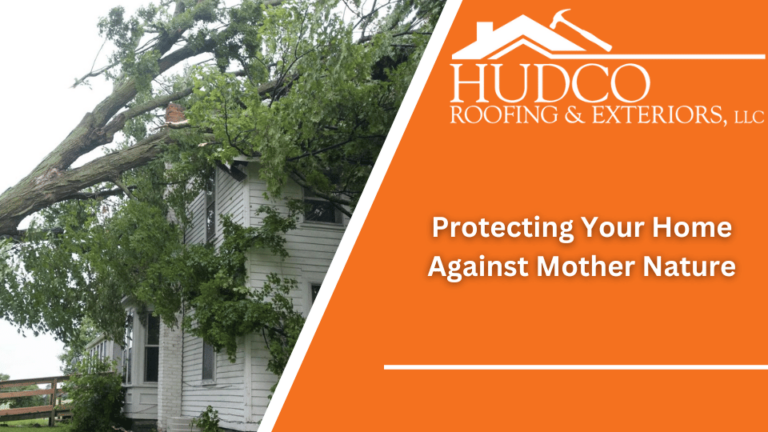Protecting Your Home Against Mother Nature with HUDCO Roofing & Exteriors. When it comes to safeguarding your home against the fury of Mother Nature, your roof plays a crucial role. Storms, including hurricanes, tornadoes, severe thunderstorms, and heavy snowfall, can subject your roof to extreme forces. To protect your home and family, investing in storm-resistant roofing materials and construction is essential. In this article, we’ll explore the importance of storm-resistant roofing and the materials that can help fortify your home against nature’s wrath.
Protecting Your Home Against Mother Nature
The Importance of Storm-Resistant Roofing:
Protection: A storm-resistant roof is your first line of defense against weather-related damage. It shields your home from rain, hail, strong winds, and flying debris, preventing water intrusion and structural damage.
Safety: A well-constructed and storm-resistant roof ensures the safety of your family. It minimizes the risk of roof failure, which can lead to catastrophic consequences during severe weather events.
Insurance Savings: Some insurance companies offer discounts or incentives for homeowners with storm-resistant roofing. Installing such a roof may lead to reduced insurance premiums, saving you money in the long run.
Property Value: Storm-resistant roofing adds to the overall value of your home. It can make your property more appealing to potential buyers and increase its resale value.
Peace of Mind: Knowing that your home is equipped with a storm-resistant roof provides peace of mind during stormy seasons. You can rest assured that your investment is well-protected.
Storm-Resistant Roofing Materials:
Impact-Resistant Shingles: Impact-resistant asphalt shingles are designed to withstand hail and debris impact. They have a Class 4 rating, which is the highest rating for impact resistance. These shingles are less likely to crack or break during severe weather.
Metal Roofing: Metal roofing, such as steel or aluminum, is highly resistant to wind and hail damage. It’s also durable and long-lasting, making it an excellent choice for storm-prone areas.
Slate Roofing: Slate is a natural stone material that is incredibly durable and can withstand heavy winds and hail. While it can be more expensive, its longevity and resistance to damage make it a worthwhile investment.
Concrete or Clay Tiles: Concrete and clay tiles are resistant to high winds and hail. They are commonly used in hurricane-prone regions due to their durability and ability to withstand severe weather.
Synthetic Roofing Materials: Some synthetic roofing materials are designed to mimic the appearance of traditional materials like slate or wood while offering enhanced durability and storm resistance.
Additional Storm-Resistant Features:
Reinforced Roof Decking: The decking or sheathing beneath your roofing material should be sturdy and properly secured to withstand strong winds. Reinforced decking can prevent uplift and damage to the roof’s structure.
Proper Installation: Proper installation is critical for storm-resistant roofing. Ensure that your roofing contractor follows industry standards and manufacturer recommendations for installation.
Impact-Resistant Underlayment: An impact-resistant underlayment adds an extra layer of protection beneath your roofing material, helping to prevent water infiltration during severe storms.
Hurricane Clips or Straps: Hurricane clips or straps can help secure the roof to the home’s frame, preventing it from being lifted during high winds.
Regular Inspections: Regular roof inspections can identify and address any issues or damage before a storm occurs. Addressing minor problems promptly can prevent more extensive damage during a storm.
Installation and Maintenance:
Proper installation and maintenance are essential for ensuring the effectiveness of storm-resistant roofing. Here are some tips:
Choose a Reputable Contractor: Select a licensed and experienced roofing contractor with a track record of installing storm-resistant roofing materials.
Regular Inspections: Schedule regular roof inspections, especially after severe weather events, to check for any damage or loose components.
Trim Trees: Trim or remove trees near your home that could pose a risk during a storm, such as branches that could fall onto the roof.
Clean Gutters and Drains: Keep gutters and drains clear of debris to prevent water buildup on the roof during heavy rainfall.
Secure Loose Items: Before a storm, secure loose outdoor items that could become projectiles in high winds, potentially causing roof damage.
Conclusion: Protecting Your Home Against Mother Nature
Storm-resistant roofing is an investment in the safety and longevity of your home. It provides protection against severe weather events, enhances property value, and offers peace of mind. When considering storm-resistant roofing materials, consult with a reputable roofing contractor who can guide you in choosing the best option for your area’s specific weather challenges. By prioritizing the resilience of your roof, you’re taking a proactive step in safeguarding your home against nature’s fury.
HUDCO Roofing & Exteriors can provide you with the help you need. You can get in touch with us by calling us at 318-310-8505. We service areas in Alexandria, Houma, and Ruston, LA.



